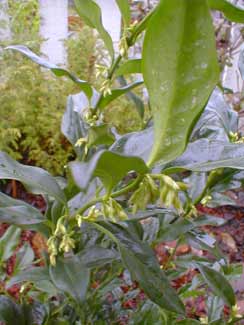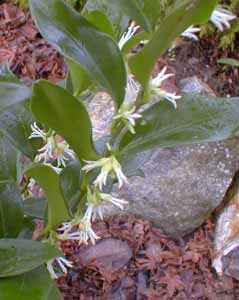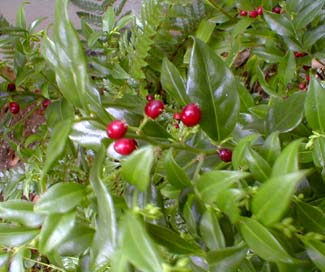
Fragrant Sweetbox
"To be overcome by the fragrance of flowers
is a delectable form of defeat.
-Beverley Nichols
(1898-1983)
(1898-1983)
Sarcococca ruscifolia is commonly called Fragrant Sweetbox (often as two words, Sweet Box). It has a slow growth rate to five by five feet, larger over time if not occasionally pruned.
The flowers are small but contrast nicelyto the shiny evergreen dark-green leaves. It is fully budded at mid-winter. Buds begin the palest greenish-white as shown in the first January photo. These open to a pure creamy white, some of them dangling, as shown in the second portrait later in January (2004). Blooms last throughout February.
 Sometimes called a Vanilla Plant due to the scent of its flowers, the redolence is not invariably overt. It does have a faint pleasing odor, & the flowers occur so early in the year that other fragrant blooms aren't competing for the attention of one's nose. If a patio of woodland garden is sufficiently enclosed that the scent isn't instantly lost upon a breeze, the perfume will accumulate for a more pronounced effect, & the effect can also be enhanced by planting more specimens; we have only one S.ruscifolia but it is assisted in perfuming the shade corridor by two dwarf sweetboxes (S. humilis) that are nearly identical save only for size.
Sometimes called a Vanilla Plant due to the scent of its flowers, the redolence is not invariably overt. It does have a faint pleasing odor, & the flowers occur so early in the year that other fragrant blooms aren't competing for the attention of one's nose. If a patio of woodland garden is sufficiently enclosed that the scent isn't instantly lost upon a breeze, the perfume will accumulate for a more pronounced effect, & the effect can also be enhanced by planting more specimens; we have only one S.ruscifolia but it is assisted in perfuming the shade corridor by two dwarf sweetboxes (S. humilis) that are nearly identical save only for size.It is best located near a path to take advantage of such mildly scented winter blossoms. They can also be used in bouquets to bring this faint scent to the center of a table.
Blooms are followed by slowly developing drupes. These ripen blood-red to red-black by early autumn & last until autumn's end.The genus name is a redundancy meaning Fruit (Sarcos) Berries (Cocca), as the drupes do provide the shrub a most attractive feature. These berries are shown in the last photo below in November.
It sometimes has a floppy growth habit & if left to its own devices can become wider than tall, but is alternatively trainable to an espalier for an almost vine-like upward growth. If trained against a house, it is highly unlikely it will ever injure masonry, unless there are already cracks or separations into which any plant might grow.
Alternatively, it can be lightly pruned once each year, early in autumn, to preserve its form as a compactly leafed, upright, vase-shaped shrub. But it will also look nice if left to go wild in a low-maintenance semi-shade garden.

 This species is native of Central China. It was first collected in Hubei Province in 1887 by Scottish physician & amateur botanist, Augustine Henry (1857-1930), shown in the oil portrait at the left.
This species is native of Central China. It was first collected in Hubei Province in 1887 by Scottish physician & amateur botanist, Augustine Henry (1857-1930), shown in the oil portrait at the left.It was collected again in 1901 by botanist Ernest H. "Chinese" Wilson (1876-1930), shown in the photo at the right. But Fragrant Sweetbox didn't really begin to become well-known in English & American gardens until the mid 1990s, soon after the Royal Botanical Society funded new quests into Yunnan Province seeking gardenable plants, bringing back seeds gathered at high elevations for especially strong cold-hardiness.
Sweetbox is very hardy once its extensive root system is established in an organically rich soil which retains moisture well. In the Northwest it can be somewhat drought-hardy, though long dry spells in summer do rather demand it get a weekly watering to remain at its year-round best.
 It is sometimes recommended for those "difficult" dry shade locations where so few things flourish, but on the coast it likes dappled sunlight or bright shade, will tolerate more sun if it has to, but will not do much of interest in deep dry shade even though it won't die.
It is sometimes recommended for those "difficult" dry shade locations where so few things flourish, but on the coast it likes dappled sunlight or bright shade, will tolerate more sun if it has to, but will not do much of interest in deep dry shade even though it won't die.It is a good companion for rhododendrons or camelleas, enjoying the same organically rich topsoils & light exposure. Inland or further south it can indeed be a deeper shade shrub. Because it is a temperate shrub, it will bloom less reliably in warmer zones, as it needs to experience definite seasons.
Fragrant sweetbox is known to contain alkaloids with antibacterial & antifungal potential, & certainly the plant itself fends off plant diseases with great ease & is almost never attacked by pathogens or insects. Solvent extracts have shown some promise of nematicidal value for use against the root-knot nematode Meloidogyne incognita which attacks food crops in tropical regions.
It has been used in Asia as a topical medication & tonic, an extract being sold under the herbal remedy name Qing xiang gui. It is rarely although occasionally imported under this name for American customers who fawningly glorify Chinese herbal medicine. Believers' usual argument runs, "Duhhh, since no one can explain to me how accupuncture works, it does work, therefore any random herb that says 'Chinese' on it is a magic cure for anything anyone tells me it will cure." Well, okay, it's good for curing stupidity if you poke it in your eyes!
Such believers don't want to hear about deaths, health injuries, highly toxic contaminants such as mercury & lead, & unproven viability of the majority of the plants that have landed indiscriminatingly onto the Chinese pharmacopeia. In the present example there is a good likelihood that Sweetbox indeed has some of the same sorts of values similar to witchhazel, as the extracts have a known antibacterial potential. But controlled studies to prove or disprove actual & specific medicinal benefits from the steroidal alkaloids in shrubs of the Saracocca genus, & assessments of potential hazards, have yet to be undertaken.